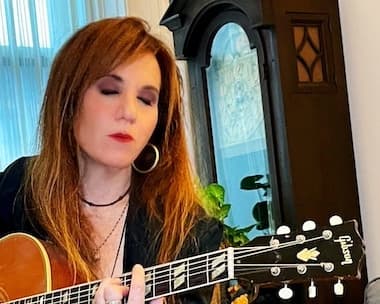If Cole Porter Had Gone Country: Janie Barnett Explores the Possibilities
This is a highly understated album, with most tempos on the slower end of metronome; it has a fuzzy, amorphous sound that reminds me of K.D. Lang singing ‘Don’t Smoke in Bed.’

Janie Barnett
‘Under My Skin: Reimagining Cole Porter’
Janie Barnett Music
For most of the last 60 years, there’s been no shortage of jazz and traditional pop artists taking songs from outside their traditions, opening them up, and reinterpreting them according to their own dictates: Ray Charles and Nat King Cole struck gold with their unique versions of famous country and Western songs; Frank Sinatra sang George Harrison’s “Something” as if it had been written by Johnny Mercer and Harold Arlen. Sometimes it works the other way around, as when Bob Dylan took on several dozen gems from the Sinatra songbook.
The year 2010 saw “Brian Wilson Reimagines Gershwin,” and Michael Feinstein did something even more surprising 11 years later when he released “Gershwin Country,” for which the veteran cabareteur took classic songs by George and Ira and “re-imagined” them as if they had come from Nashville, Memphis, and Bakersfield rather than Tin Pan Alley, Hollywood, Broadway, or even Peru, Indiana.
Now, Janie Barnett’s “Under My Skin” reimagines Cole Porter in a comparable fashion.
Not that her Porter album sounds anything like Mr. Feinstein’s — his is a more old-school definition of country, whereas Ms. Barnett’s is kind of a postmodern approach more closely aligned with contemporary singer-songwriter folk music. This is a highly understated album, with most tempos on the slower end of metronome; it has a fuzzy, amorphous sound that reminds me of K.D. Lang singing “Don’t Smoke in Bed.”
Ms. Barnett starts with “I’ve Got You Under My Skin,” which was first heard in the 1936 film “Born to Dance” as a slow torch song set in a vaguely bolero-ish groove before Sinatra reimagined it as a brash uptempo song for swinging lovers. Ms. Barnett and company slow it down, and in place of Sinatra and Nelson Riddle’s Count Basie-inspired forward-charging moment, they take it through all sorts of twisty turns. Sinatra and Riddle drive it down a superhighway at 100 miles an hour; Ms. Barnett and her band take it down an old country road.
“Night and Day” has a distinctly bluegrass feeling, with Sierra Hill playing mandolin and Ms. Barnett sharing the vocal with Keith Sewell; this itself is unusual, as the song is generally presented as something of interior monologue rather than a duet, even though it was the inspiration for one of Fred Astaire’s most iconic partner dances.
“In the Still of the Night” has a very open, spare sound, which actually suggests a quiet forest after midnight. Larry Campbell plays lap pedal steel guitar here, but it doesn’t sound like vintage country so much as the wilderness at twilight; as if you’re staring up at the stars and your eyes are playing tricks on you, like a dream that fades out of sight and “the moon going dim.”
“Ev’ry Time We Say Goodbye,” one of Porter’s saddest and most iconic songs, is here somewhat more cheerful, though still rather slow. The track opens with Antoine Silverman’s wailing violin, but is also one of the few here where the piano, played by Ben Stivers, is the primary accompaniment for Ms. Barnett’s voice; for once this goodbye song is more optimistic than melancholy. There’s a jazz interlude for Mr. Stivers and bassist Richard Hammond that instills a kind of saloon-y feeling, and that, in turn, serves, among other things, to make me feel thirsty.
Although I confess it’s fun trying, one can’t imagine Elvis Presley singing “Ev’ry Time We Say Goodbye,” but he did sing “True Love,” which is generally considered Porter’s final substantial hit. As opposed to “Night and Day,” “True Love” is supposed to be a duet — it was written for Bing Crosby and Grace Kelly in “High Society” (1956) — so, appropriately, she’s joined by Cliff Eberhardt. This also has a nocturnal sound, but the feeling in the voices makes it sound romantic rather than spooky.
With 16 tracks running 60 minutes, this is a particularly generous offering — especially because one cut co-stars the sublime Catherine Russell, and that’s worth the price of admission right there. I’ve never heard a “You’re the Top” quite like this one, but the two singers capture the sense of camaraderie and good humor that Porter was obviously going for.
“You Do Something to Me” was recorded live at City Winery, which is also where Ms. Barnett performed a brunchtime show of this music a few weeks ago. The tune here is in a fast, hoe-down kind of a tempo, virtually the only track that could inspire a square dance. Now that would be a first for Cole Porter.

